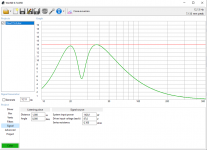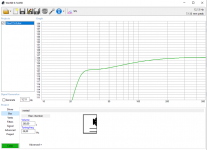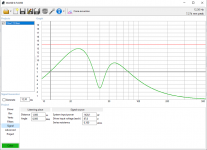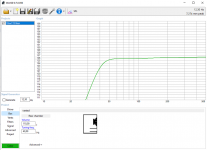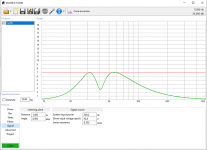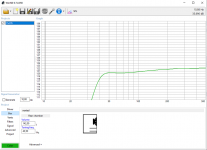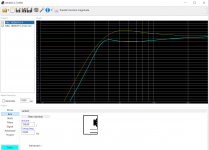Hello, I'm simulating cabs in WinISD primarily for educational purposes, I've built a few tried and tested designs from this forum and others before, but have not built anything I've simulated myself.
I've got two 18sw115-8 hence I simulate a bit with these to see what they could deliver in a ported design. I've also simmed some with for example the 15cl76 driver.
What caught my attention when comparing designs with these two drivers is, that with the 18sw115-8 I cannot seem to get a linear frequency response while making use of all the drivers excursion in, as far as my rather novice mind can make up, a satisfying way. Either the frequency response is linear and the excursion is way lower than what the driver is capable of (In a small box), or the frequency response is raising quite a bit when the box is big enough and appropriate filters are applied for the excursion to look good to me (when applied 87 volts to both cabs, which is what I feed them in my Keystones).
However when I sim with the 15cl76 I think it looks more balanced, with a good flat response and the excursion curve looks better to me.
I've included 6 pics of the boxes:
1. The simmed response and excursion of the raising response, big ported box for 18sw115-8.
2. The small box, linear response box for 18sw115-8.
3. Aswell as the to me rather balanced looking box for 15cl76.
Does the response and excursion of the 15cl76 reveal that this driver is more optimal for ported enclosures? Which of the cabinets of the 18sw115-8 will sound better and work better in conjunction with that driver, regardless of extension and cab size? The ports and filters of all three cabs results in a port velocity of between 16-18 ms.
I hope these questions make sense, I'm not sure how relevant this is or if I made any mistakes in the simulations, however it is something that caught my mind when simulating.
Thanks for any input on this. BTW "Liten" In Swedish mean "small" and "Stor" in Swedish mean "Large" 🙂
I've got two 18sw115-8 hence I simulate a bit with these to see what they could deliver in a ported design. I've also simmed some with for example the 15cl76 driver.
What caught my attention when comparing designs with these two drivers is, that with the 18sw115-8 I cannot seem to get a linear frequency response while making use of all the drivers excursion in, as far as my rather novice mind can make up, a satisfying way. Either the frequency response is linear and the excursion is way lower than what the driver is capable of (In a small box), or the frequency response is raising quite a bit when the box is big enough and appropriate filters are applied for the excursion to look good to me (when applied 87 volts to both cabs, which is what I feed them in my Keystones).
However when I sim with the 15cl76 I think it looks more balanced, with a good flat response and the excursion curve looks better to me.
I've included 6 pics of the boxes:
1. The simmed response and excursion of the raising response, big ported box for 18sw115-8.
2. The small box, linear response box for 18sw115-8.
3. Aswell as the to me rather balanced looking box for 15cl76.
Does the response and excursion of the 15cl76 reveal that this driver is more optimal for ported enclosures? Which of the cabinets of the 18sw115-8 will sound better and work better in conjunction with that driver, regardless of extension and cab size? The ports and filters of all three cabs results in a port velocity of between 16-18 ms.
I hope these questions make sense, I'm not sure how relevant this is or if I made any mistakes in the simulations, however it is something that caught my mind when simulating.
Thanks for any input on this. BTW "Liten" In Swedish mean "small" and "Stor" in Swedish mean "Large" 🙂
Attachments
Last edited:
Greets!
No, per this, their specs make them both strictly vented alignment drivers: Red Spade Audio: Efficiency Bandwidth Product (EBP)
Please calculate the optimal alignment for each driver and input them to compare for frame of reference before going any further:
T/S max flat ['critically' damped] vented alignment:
net volume [Vb] [L] = 20*Vas*Qts'^3.3
box tuning [Fb] [Hz] = 0.42*Fs*Qts'^-0.96
Qts' = Qts + any added series resistance [Rs]: Calculate new Qts with Series Resistor
[Rs] = 0.5 ohm minimum for wiring, so may be higher if a super small gauge is used as a series resistor plus any added resistance from an XO/whatever.
No, per this, their specs make them both strictly vented alignment drivers: Red Spade Audio: Efficiency Bandwidth Product (EBP)
Please calculate the optimal alignment for each driver and input them to compare for frame of reference before going any further:
T/S max flat ['critically' damped] vented alignment:
net volume [Vb] [L] = 20*Vas*Qts'^3.3
box tuning [Fb] [Hz] = 0.42*Fs*Qts'^-0.96
Qts' = Qts + any added series resistance [Rs]: Calculate new Qts with Series Resistor
[Rs] = 0.5 ohm minimum for wiring, so may be higher if a super small gauge is used as a series resistor plus any added resistance from an XO/whatever.
That is 1892 W into 4 ohms. They might take a bit more, as B&C claims 1700 W continuous power handling (2 hours, pink noise, free air, band limited to fs .. 10*fs) and music has a certain crest factor. I am not sure on this.... when applied 87 volts to both cabs, which is what I feed them in my Keystones).
The 18SW115-8 is a modern PA driver. These usually are designed with a strong motor. A strong motor is good for efficiency but results in a rising frequency response, with increasing frequency. The rising response is supposed to be equalized to a target curve with a DSP. I see this is not exactly what is happening with this woofer in its recommended enclosure, but it is good to know that the raw frequency response is not that important. Maximizing sound output for a given packaging size and price tag is more important. Also keep in mind that the coil will be hot during use, which increases Re.... with the 18sw115-8 I cannot seem to get a linear frequency response while making use of all the drivers excursion in, as far as my rather novice mind can make up, a satisfying way. Either the frequency response is linear and the excursion is way lower than what the driver is capable of (In a small box), or the frequency response is raising quite a bit when the box is big enough and appropriate filters are applied for the excursion to look good to me (when applied 87 volts to both cabs, which is what I feed them in my Keystones).
The recommended enclosure is 150 L, tuned at 35 Hz.
https://www.bcspeakers.com/en/products/lf-driver/18-0/4/18sw115-4
Attachments
Last edited:
Greets!
No, per this, their specs make them both strictly vented alignment drivers: Red Spade Audio: Efficiency Bandwidth Product (EBP)
Please calculate the optimal alignment for each driver and input them to compare for frame of reference before going any further:
T/S max flat ['critically' damped] vented alignment:
net volume [Vb] [L] = 20*Vas*Qts'^3.3
box tuning [Fb] [Hz] = 0.42*Fs*Qts'^-0.96
Qts' = Qts + any added series resistance [Rs]: Calculate new Qts with Series Resistor
[Rs] = 0.5 ohm minimum for wiring, so may be higher if a super small gauge is used as a series resistor plus any added resistance from an XO/whatever.
Thanks! I got 96.4 liters and tuning at 38.96hz for the 18sw115-8 and a rs of .5 with the calculator you provided, I'm not at the computer until Sunday so will insert these numbers in winisd then and see how it looks. Does it look about right? Do I understand you right that this could be considered the optimal alignment for flat response with the 18sw115-8? Or is this alignment merely a reference to compare simulated ported box potency of different drivers?
I googled critically damped alignment and what I could understand it's main purpose to be is to minimise ringing of a driver+cab combination. Would this be perceived as transparent bass if my assumption is correct?
Last edited:
That is 1892 W into 4 ohms. They might take a bit more, as B&C claims 1700 W continuous power handling (2 hours, pink noise, free air, band limited to fs .. 10*fs) and music has a certain crest factor. I am not sure on this.
The 18SW115-8 is a modern PA driver. These usually are designed with a strong motor. A strong motor is good for efficiency but results in a rising frequency response, with increasing frequency. The rising response is supposed to be equalized to a target curve with a DSP. I see this is not exactly what is happening with this woofer in its recommended enclosure, but it is good to know that the raw frequency response is not that important. Maximizing sound output for a given packaging size and price tag is more important. Also keep in mind that the coil will be hot during use, which increases Re.
The recommended enclosure is 150 L, tuned at 35 Hz.
https://www.bcspeakers.com/en/products/lf-driver/18-0/4/18sw115-4
Thanks, as I've got the 8 ohm driver 87 volts should be about 1300-1400 watts if the Zmin of the driver+keystone combination stays around 6.5 ohm, which I'm not sure of. I've tried giving it 95 volts once for about 2-3 hours and it definitely kicked in a higher gear but I've not dared to try it again, it was super loud and clean however 🙂
Is finding a good balance between good excursion graphs and okayish frequency response a good preference, then Eq to taste? It's kinda sad to see low excursion figures from the 18sw-115 in small cabinets even with high power applied, isn't that throwing away the drivers potential to some extent?
One of my rules of thumb when simulating a driver is to not have more than one zero crossing of the derivative of the FR. All of you sims fail that criteria.
dave
dave
Thanks! I got 96.4 liters and tuning at 38.96hz rather close to my small 18sw115 box which is much more linear in frequency response) for the 18sw115-8 and a rs of .5 with the calculator you provided, I'm not at the computer until Sunday so will insert these numbers in winisd then and see how it looks, my gut feeling tells me low on excursion with high power applied. Does it look about right? Do I understand you right that this could be considered the optimal alignment for flat response with the 18sw115-8? Or is this alignment merely a reference to compare simulated ported box potency of different drivers?
I googled critically damped alignment and what I could understand it's main purpose to be is to minimise ringing of a driver+cab combination. Would this be perceived as transparent bass if my assumption is correct?
Last edited:
Does it look about right? Do I understand you right that this could be considered the optimal alignment for flat response with the 18sw115-8? Or is this alignment merely a reference to compare simulated ported box potency of different drivers?
I googled critically damped alignment and what I could understand it's main purpose to be is to minimise ringing of a driver+cab combination. Would this be perceived as transparent bass if my assumption is correct?
You're welcome!
Didn't sim them, but they will be the flattest on axis response the driver's specs can reproduce up to its upper mass corner where T/S theory peters out and down to a half octave below the equivalent sealed cabinet's resonance [F3]: Fhm = 2*Fs/Qts'
Both.
There's 'critically' damped, which in audio is a 0.5 Qt alignment [normally sealed], then there's the 0.707 Qt 'critically' damped reflex alignment.
Correct.
I guess that depends on one's definition, but the room dominates the bass BW, so in most cases the bass must be over-damped to blend with the room's eigenmodes, room, boundary gain.
One of my rules of thumb when simulating a driver is to not have more than one zero crossing of the derivative of the FR. All of you sims fail that criteria.
dave
Thanks for your response.
This is above my level of understanding unfortunately. How can you come to this conclusion from the pics I've uploaded? Maybe if you explain that I could understand the concept. I don't know what either the multiple zero crossings you are referring to are nor what the derivate of fr is.
Everytime the FR sim changes direction, ie when a tangent to the FR curve is a horizontal line that is when the derivative is zero.
The last 2 sims just on the edge, the first is just really droopy. Be perfect if it mirrored your room gain. It is flat section below where it starts rolling off, and then the steep rooloff below that.
dave
The last 2 sims just on the edge, the first is just really droopy. Be perfect if it mirrored your room gain. It is flat section below where it starts rolling off, and then the steep rooloff below that.
dave
- Home
- Loudspeakers
- Subwoofers
- A few questions about 3 WinISD designs.
